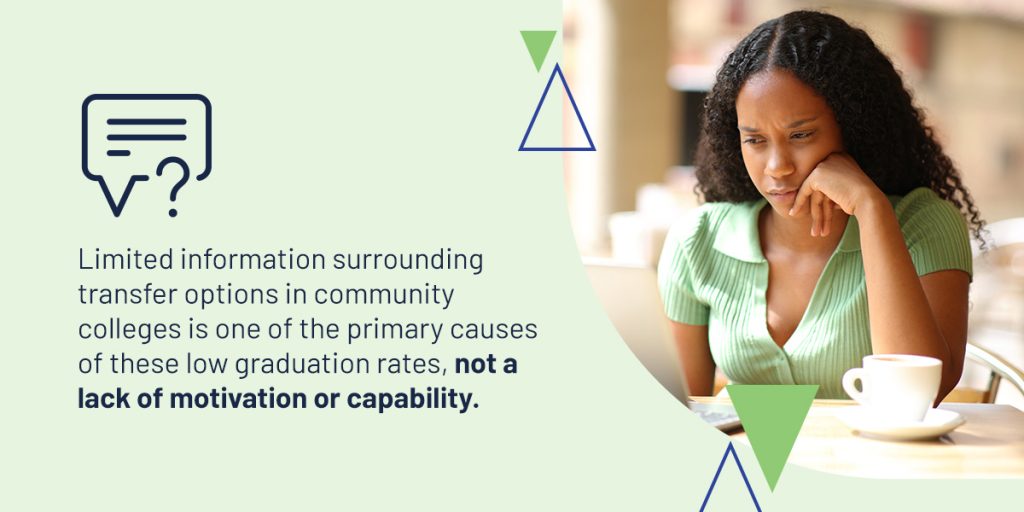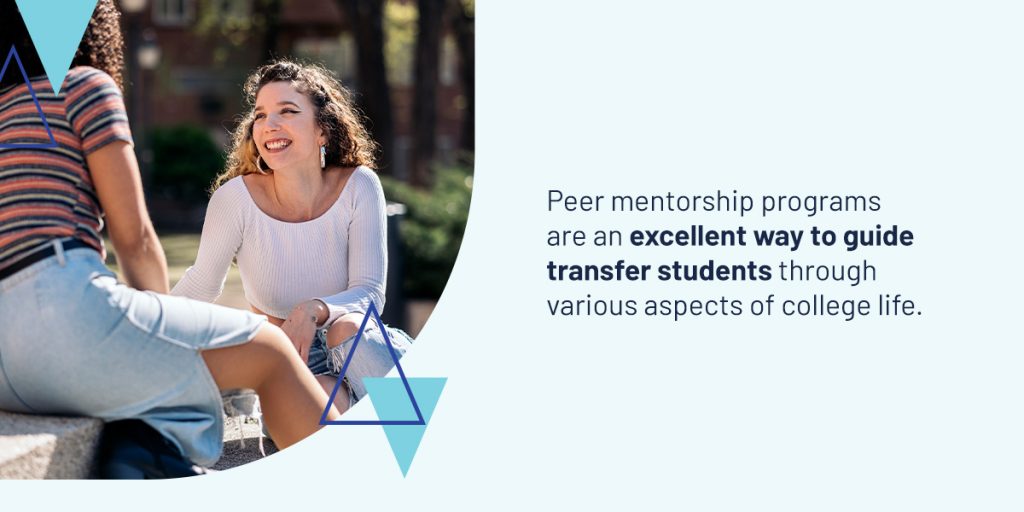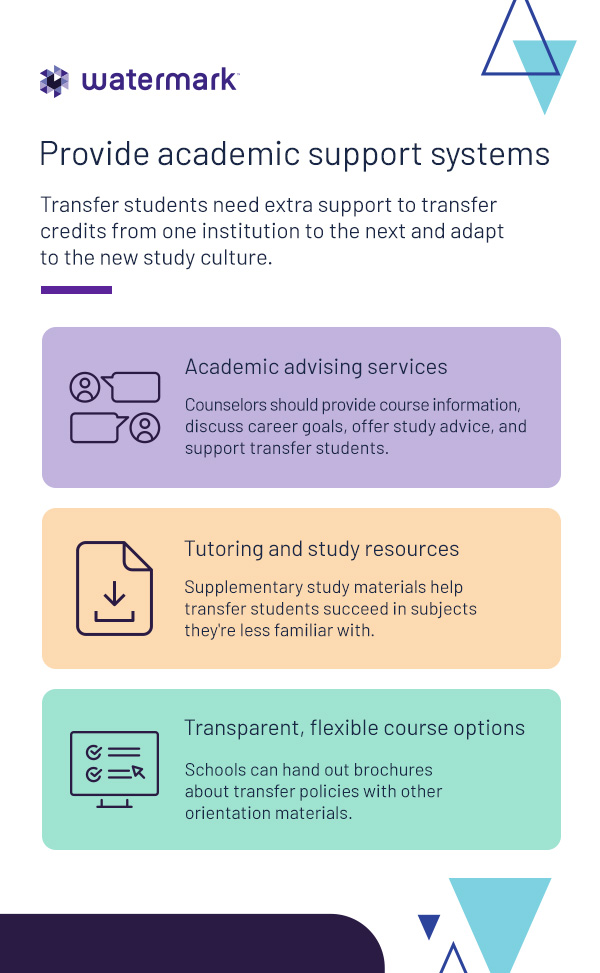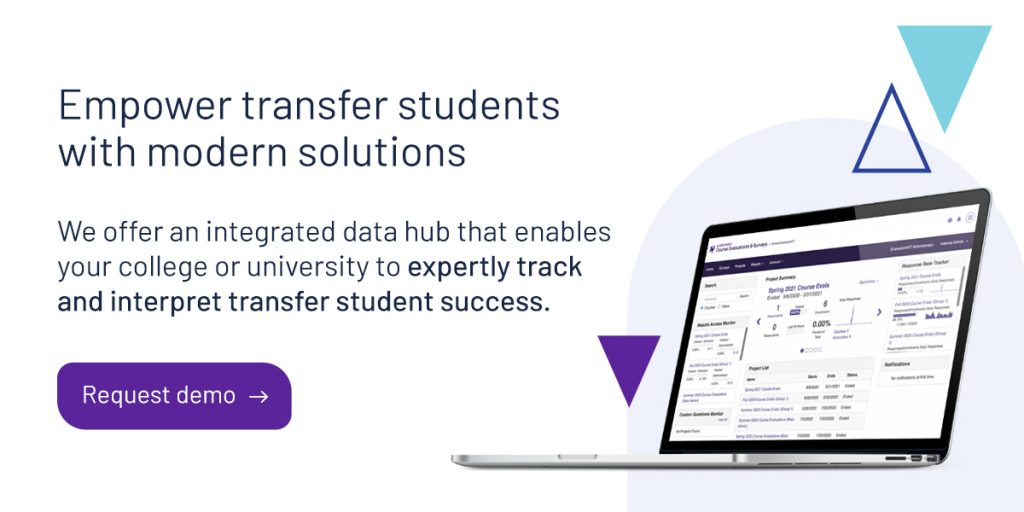




Transfer students show immense promise and ambition in academia, although they face significant administrative and cultural barriers to success both before and during their transfer. While new research shows that nearly 80 percent of community college students plan to transfer to a four-year higher education institution, only 33 percent actually do, and fewer than half of those transfer students graduate with a bachelor’s degree within six years of starting community college despite their goals.
This trend demonstrates a growing need for tertiary education institutions and faculty members to help transfer students qualify, apply, and adjust to four-year college life. According to the National Institute for the Study of Transfer Students, with the right streamlined policies, social support systems, inter-institutional collaboration, feedback avenues, and data management solutions, transfer students will have better chances of embracing, completing, and excelling at their college experience and chosen career paths. Read on to learn how you can empower students — and the institutions they represent — to reach their full potential.
Although two-year community colleges are most responsible for preparing and facilitating their students for transfer, it’s still critical for institutions on the receiving end to fully understand what limitations transfer students face to best support them when they arrive. Many factors can influence how easy it is for community college students to transition to college and universities, including where they’re from, what they’re studying, and other extra-curricular responsibilities.
Learners from under-resourced and previously disadvantaged communities need the most support. Studies show that, on average, only 13 percent of United States students on government financial aid ultimately earn bachelor’s degrees within eight years of starting community college, with South Dakota’s rate lower than 4 percent.

Limited information surrounding transfer options in community colleges is one of the primary causes of these low graduation rates, not a lack of motivation or capability. This stunting of academic growth perpetuates the cycle of economic disempowerment and keeps motivated families in poverty because graduates with bachelor’s degrees earn, on average, 37 percent more money than those with associate’s degrees alone.
Those who do manage to transfer face their own unique challenges once enrolled in their four-year course:
Students with family responsibilities and childcare obligations have a lot on their plate, especially if they’re holding down a job during tertiary education. Also, certain specialized fields of study can sometimes be stereotyped as gender-specific by students, faculty, and society, such as engineering as inherently “for men” and nursing “for women.”
These social pressures place extra demands on students as they navigate transferring and assimilating to their new school. Transfer student support systems should factor in these unique circumstances to create a more accessible and welcoming environment for people from all walks of life.
Transitioning from a community college setting to a university or another four-year program can be a big change for a lot of students. There are several differences between two-year institutions and four-year institutions that may pose a learning curve for transfer students upon first arrival:
These many variables are why a one-size-fits-all approach isn’t ideal for supporting transfer students. Due to their unique circumstances, students need administrators and educators to formulate multifaceted strategies that consider psychological, social, logistical, academic, and other factors.
Campuses should warmly welcome transfer students to give them the best chance at smooth and comfortable adjustment. Because their previous educational backgrounds may have differed significantly from their new situation, thorough orientation, information, and encouragement are crucial to setting transfer students up for success.
Higher education administrators can work with student councils to build comprehensive orientation programs and events that help acquaint transfer students with their new school. A strong welcome will ease anxieties, spark new relationships with other students, and make it easier for new students to ask questions and navigate their new environment. With the right orientation, students will feel more seen, valued, and prioritized during this often overwhelming time, building their confidence.

Peer mentorship programs are an excellent way to guide transfer students through various aspects of college life. A contactable, experienced mentor gives transfer students more direct access to day-to-day need-to-know information. Preferably, schools should select mentors who were once transfer students themselves. This first-person perspective gives mentors insight into what their mentees might not know or would appreciate having explained.
Social integration is an often-overlooked yet pivotal tool schools can use to lay a solid foundation for their transfer students. By getting to know their peers, new learners feel part of the campus community and can build supportive friendships with classmates and dormitory members.
These relationships, preferably supplemented by mentorship and sparked by orientation programs, will assist transfer students in critical daily college activities, such as:
Supportive social frameworks should extend beyond the welcoming phase, as initial orientation can be a lot of information all at once and might not cover some of the more nuanced, situational topics that will be pertinent later in the year. Transfer students need ongoing, adaptive resources so they can conquer some of the “slower-burn” hurdles they may face. Useful networks administrators can set up for their transfer students include:
One of the most valuable ways receiving schools can support their prospective transfer students is by building solid partnerships with two-year institutions. With transparent and consistent collaboration, institutions can clarify paramount information and opportunities for prospective transfer students, such as:
Connecting current transfer students with alumni — particularly former transfer students — can provide essential mentorship opportunities, seminars, and workshops, financing options, and firsthand career insights. Alumni can also provide valuable networking opportunities that transfer students can use to fulfill community service requirements, find internships, gain work experience, and apply for jobs in their field.

One of the biggest challenges transfer students face is adapting to the new academic climate and choosing the right classes for their preferred career path. While academic guidance is critical for all scholars, transfer students need extra support to transfer credits from one institution to the next and adapt to the new study culture.
Just as on-campus mental health resources are essential for student well-being, so academic counseling services are for facilitating success and helping students reach their goals. This can be particularly true for transfer students entering their degree with preexisting credits. Counselors should provide course information, discuss career goals, offer study advice, and support transfer students in adapting to their new schooling environment.
Supplementary study materials help transfer students succeed in subjects they’re less familiar with. Student tutors are a great resource for catching transfer students up and consolidating information through practice tests. Tutors can explain unclear concepts, teach the transfer student coursework not covered in their previous curriculum, and ensure transfer students can access resources like the library, printers, and online journal archives.
Faculty from two- and four-year schools will do well to simplify and streamline the academic and logistical aspects of transferring schools, as credits pose a significant roadblock for high-potential learners. The American Council of Education created the National Task Force on the Transfer and Award of Credit in March 2020 to help college administrators streamline credit transfer policies. Some of the many successful policies that this task force highlights are:
Norfolk State University (NSU) Passport Program
Pennsylvania State Transfer Policies
Transfer Michigan State University (MSU)
While having these streamlined is critical, institutions must still make students aware that these options are available for them to have any significant effect. Schools can hand out brochures about transfer policies with other orientation materials, send out targeted emails with links to relevant online portals, and even discuss these options in class for maximum reach.
Data collection and interpretation can help institutions track the success of their transfer students and gauge how well each support strategy is working. Fortunately, we are long past the days of physical suggestion boxes. There are highly efficient software suites colleges and universities can use to collect, manage, and measure the success of each transfer student empowerment effort — both qualitatively and quantitively. The key facets to investigate are:
Support systems are, first and foremost, created for student welfare, and their lived experiences should be the driving force behind policy changes and new initiatives. By providing transfer students with a user-friendly survey application through which to give detailed, actionable feedback, your institution can gain valuable insights and learn what to focus on and where to pivot. Transfer students will also greatly appreciate their voices being heard.
Select software that prompts students to engage for the most thorough and diverse feedback and requires as little IT engagement as possible. The suite should be doing the heavy lifting while you focus on strategies and student welfare. Surveys can include feedback on various issues affecting transfer students, from thoughts on orientation programs to the availability of support resources and course and faculty evaluations.
Research indicates that when institutions prioritize transfer students and create a supportive environment, retention rates improve significantly. Analyzing retention rates among transfer students provides valuable insights into their transition experiences. Some helpful information you could learn about retention through smart data capturing includes:
Institutions should utilize software that tracks transfer student academic performance to identify areas needing additional faculty guidance and resources. GPA trends, course completion rates, and participation in academic support programs are some of the many metrics by which your institution can gauge transfer student assimilation. You’ll also be able to develop targeted interventions to assist students where they need it most.
Ideally, the software you choose to collect and interpret your data should provide centralized, contextualized insights so you can look at the bigger picture, including feedback, retention rates, and academic performance and how they correlate. With all your data in one place managed by the same system, you can access the information quicker, easier, and in a descriptive, intuitive format.
Watermark has spent the last 20 years empowering thousands of higher education institutions with highly efficient data collection and in-depth evaluation tools. We offer an integrated data hub that enables your college or university to expertly track and interpret transfer student success, effective orientation strategies, and valuable feedback.
Our dynamic, holistic data collection, measurement and analysis software lets you adapt to the changing landscape of higher education while planning, pursuing and measuring institutional goals. If you’re interested in streamlining your data and gaining unprecedented clarity through context, request a demo from us today.






























































































































































































































































































































































































